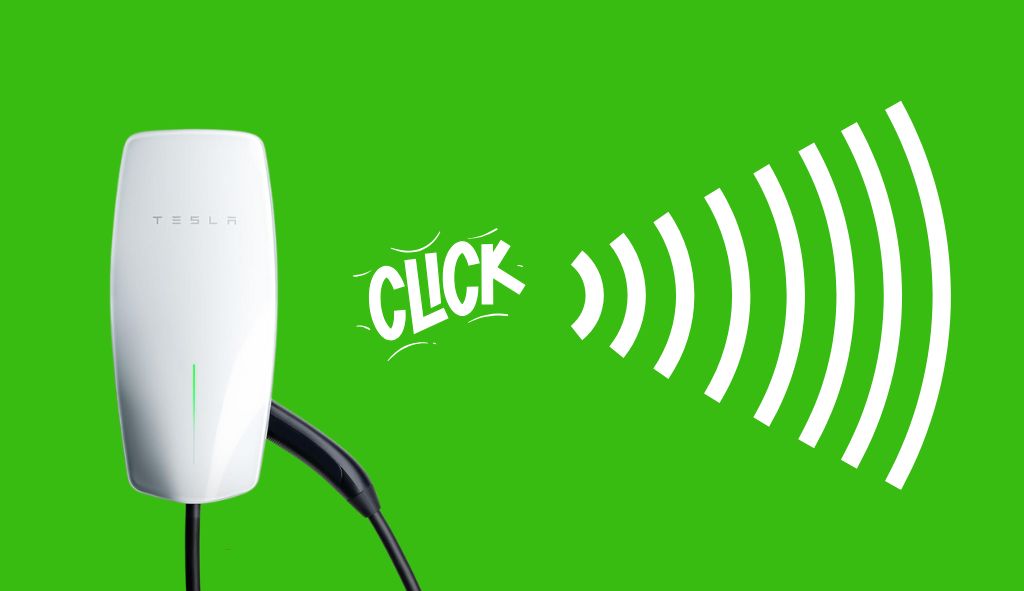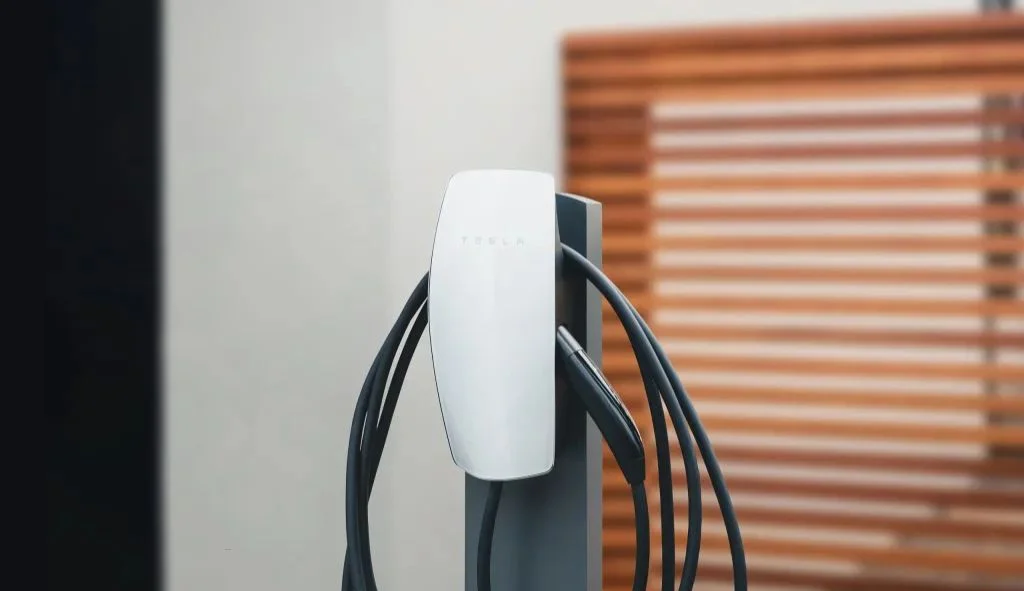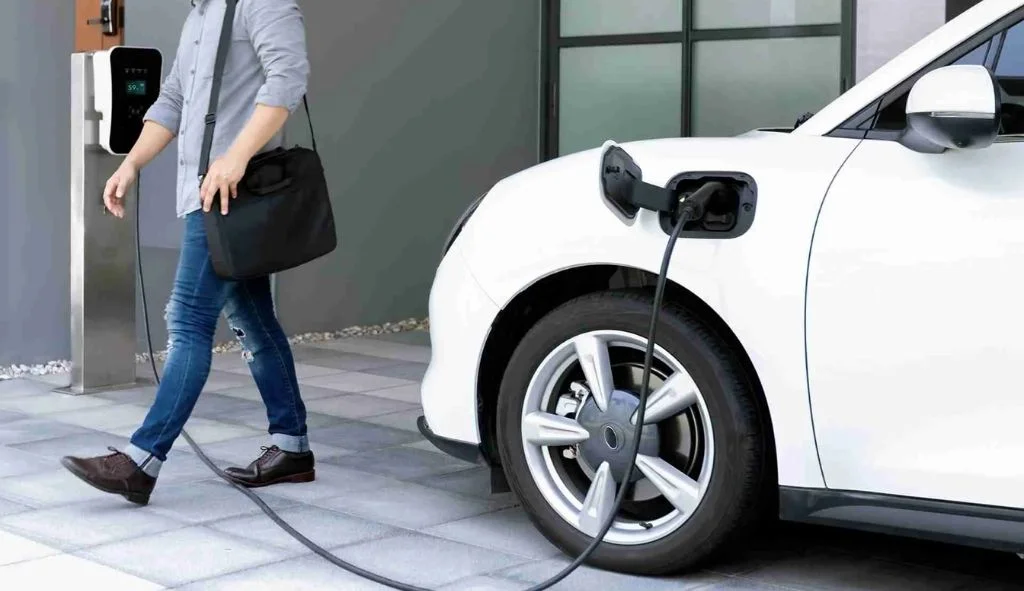Tesla wall chargers produce clicking sounds due to relays and contactors activating during normal charging operations. While typically normal, excessive or abnormal clicking may indicate connection issues requiring attention.
Understanding Tesla Wall Charger Clicks
When you plug in your Tesla to charge, you might hear various sounds coming from the wall charger. These sounds often cause concern for new Tesla owners who aren’t familiar with the normal charging process. The clicking sound is one of the most common noises you’ll hear, and in most cases, it’s completely normal. Understanding why these sounds occur can help you determine when there’s actually a problem that needs attention.
Normal Operational Sounds
The clicking sound from your Tesla wall charger is usually the sound of contactors and relays working properly. These are electrical components inside the charging system that control the flow of electricity from your home to your vehicle. When you first connect your Tesla to the charger, you’ll typically hear one or two distinct clicks as the system establishes the connection and begins charging. This initial clicking is the wall connector’s relay closing to complete the circuit between your home’s power supply and your Tesla’s battery.
You might also hear additional clicks when charging stops or when the charging rate changes. These clicks signal that the charging system is responding to changes in the vehicle’s needs or the power supply. The clicks help ensure that electricity flows safely and efficiently to your vehicle’s battery. Many Tesla owners report hearing these sounds regularly, and Tesla service technicians confirm that they’re a normal part of the charging process.
The Role of Contactors and Relays
Contactors and relays are essentially electrical switches that allow high voltage electricity to flow when needed and stop it when not needed. Their job is crucial for the safety and efficiency of the charging process. When you plug in your Tesla, the wall connector needs to verify that a proper connection exists before allowing electricity to flow at full power. The contactors physically close to create a connection, making the clicking sound you hear.
These components prevent the connector from being “live” with power when it isn’t plugged into your car, which is an important safety feature. Without this protection, the exposed end of your charging cable could potentially carry dangerous levels of electricity. The click/knock sounds you hear are mechanical indications that these safety systems are working correctly. Each time you start or stop charging, the relays must physically connect or disconnect, resulting in the characteristic clicking sound that travels through the charging cable and sometimes even through your walls.
Causes of Clicking Sounds
While clicking sounds are often normal, different patterns or frequencies of clicks might indicate various conditions. Understanding the different causes can help you determine whether the sounds you’re hearing require attention or are just part of normal operation.
Normal Contactors Operation
The most common and expected cause of clicking sounds is the normal operation of contactors in the charging system. These sounds typically occur:
- When you first plug in your Tesla to the wall connector
- When charging begins after connection is established
- When the charge rate changes during the charging session
- When charging completes and the system disconnects
- When you unplug the connector from your vehicle
Many Tesla owners report that their wall connectors make one firm click at the car and one firm click at the charger when connecting. This double-click pattern is completely normal and indicates proper operation of the charging system. The clicking you hear confirms that the safety mechanisms are working as designed.
Some wall connectors also produce periodic clicks during charging as they adjust power delivery to match your car’s needs. This is especially common when your car approaches full charge, as the system might cycle on and off to maintain the battery at your set charge level. As one Tesla forum user explained, “The charger will fill my car to 80%, then occasionally cycle. Almost as if the charger is just keeping the car topped off at 80%.” This behavior is normal and helps maintain battery health.
Faulty Relays or Connectors
While some clicking is normal, excessive clicking or unusual patterns might indicate a problem with the relays or connectors. Faulty relays might rapidly click on and off, unable to maintain a stable connection. This issue can occur due to wear and tear, exposure to moisture, or electrical stress on the components.
Problems with the physical connection between the wall connector and your vehicle can also cause abnormal clicking. If the charging handle isn’t seated properly in your Tesla’s charging port, the system might repeatedly try to establish a connection, causing multiple clicks as it attempts to engage and disengage. Similarly, damage to the pins in either the connector or the charging port can interfere with proper electrical contact, resulting in clicking as the system tries to compensate.
Some Tesla owners have reported that their Gen 2 Wall Connectors have known issues that cause frequent clicking, particularly with Model S and Model X vehicles. According to one user report, “This is a known error with the Gen 2 HPWCs and Model S/X cars. Supposedly a software fix is coming soon.” If you have an older wall connector model, some clicking issues might be addressed in future firmware updates.
Charging Software Updates
Tesla regularly updates the software for both vehicles and wall connectors to improve performance and fix issues. During these updates, you might notice temporary changes in charging behavior, including different clicking patterns. Over-the-air updates can temporarily affect how the charging system communicates with your car, which might result in additional clicking sounds as the system readjusts.
The wall connector itself can receive firmware updates when connected to Wi-Fi. These updates might change how the charging controller manages power delivery, potentially resulting in different clicking patterns than you were previously accustomed to hearing. After an update, the system might need to recalibrate how it delivers power to your vehicle, leading to temporary changes in the frequency or pattern of clicks until the adjustment period is complete.
If you notice a sudden change in clicking behavior after an update, it’s usually not cause for concern unless accompanied by actual charging problems or error messages. Your wall connector and vehicle will typically return to normal operation after fully integrating the updated software.
Environmental Factors
The environment around your wall connector can influence its operation and the sounds it makes. Temperature fluctuations are particularly significant factors that affect charging behavior. In cold weather, especially when temperatures approach freezing, you might hear more frequent clicking from your wall connector.
According to one forum user, “The rapid clicking is normal. De-ice strategy on the contactors when the pack is close to or below freezing.” This increased clicking is part of Tesla’s thermal management strategy to ensure safe and efficient charging in cold conditions. The system might cycle power more frequently to generate heat that prevents ice formation on critical components.
High humidity, power fluctuations, and extreme heat can also affect charging behavior. Power surges or dips in your home’s electrical supply might cause the wall connector to temporarily disconnect and reconnect, producing additional clicks as it protects your vehicle from potentially harmful power conditions. Similarly, high humidity might affect electrical connections, potentially leading to more frequent clicking as the system compensates for connection quality issues.
Differentiating Normal vs. Problematic Clicking
Learning to distinguish between normal operational sounds and those that might indicate a problem is important for Tesla owners. This knowledge can help you determine when troubleshooting or professional service might be necessary.
What Normal Clicking Sounds Like
Normal clicking from your Tesla wall charger typically follows predictable patterns related to the charging process. You should expect to hear:
- A single clear click when you first plug in the connector to your vehicle
- Another click when charging begins
- Occasional clicks if the charging rate changes
- A click when charging completes
- A final click when you disconnect the charger
These normal clicks are usually crisp, distinct sounds that occur at specific times during the charging process. They don’t repeat rapidly or continue for extended periods without reason. The green light on your wall connector should remain steady during charging, with no error codes or flashing patterns that would indicate problems.
Some Tesla owners describe normal clicking as “firm” and “definitive,” occurring only at the beginning and end of the charging session. According to one user, “The relay inside the wall charger should only click on one time when plugging the cable in and one time when removing the cable.” While this is the typical pattern, some additional clicks during charging are also normal, especially as the battery approaches its set charge limit.
Warning Signs of Problematic Clicking
Abnormal clicking that might indicate a problem typically differs from normal operational sounds in frequency, pattern, or accompanying symptoms. Signs that the clicking from your wall charger might signal a problem include:
- Rapid, repeated clicking that continues for extended periods
- Clicking accompanied by the green light on the wall connector turning off and on
- Clicking patterns that occur every few seconds throughout the entire charging session
- Clicking sounds accompanied by charging interruptions or slow charging
- Error messages on your vehicle’s screen or wall connector
- Charging stopping and starting repeatedly
One Tesla owner described problematic clicking as follows: “That is not actually the normal pops and clicks of a charging Tesla. Those sound like and appear to be relays flipping on and off. You can see the green light on the wall connector stopping and starting in line with those sounds, which suggests charging is being stopped then restarted repeatedly.”
If you notice these patterns, especially if they’re accompanied by charging interruptions or error messages, you might need to troubleshoot the issue or contact Tesla support for assistance.

Troubleshooting Tesla Wall Charger Clicking
If you’re experiencing unusual clicking from your Tesla wall charger, several troubleshooting steps might help identify and resolve the issue before contacting Tesla support.
Step-by-Step Troubleshooting
Follow these steps if you’re experiencing abnormal clicking from your wall connector:
- Disconnect and Reconnect: Start by unplugging the charging connector from your vehicle, waiting about 10 seconds, and then reconnecting it. This simple reset can sometimes clear temporary communication issues between the wall connector and your Tesla. Observe whether the clicking pattern changes or resolves after reconnection.
- Check Physical Connections: Inspect the charging handle and port for any visible damage, debris, or corrosion. Ensure the connector is fully and properly seated in your vehicle’s charging port. Sometimes, a poor physical connection can cause the system to repeatedly attempt to establish proper electrical contact, resulting in multiple clicks.
- Try a Different Outlet or Location: If you’re using a mobile connector rather than a permanent wall connector, try plugging it into a different outlet. For permanent installations, try charging at a different location if possible, such as a public charging station. This can help determine whether the issue is with your home’s electrical supply or the charging equipment itself.
- Reset Your Vehicle: Perform a soft reset of your Tesla by pressing and holding both scroll wheels on the steering wheel until the screen turns off and the Tesla logo appears. This reset doesn’t affect any settings but refreshes the vehicle’s computer systems, which might resolve communication issues with the charger.
- Check Circuit Breaker: Verify that the circuit breaker supplying power to your wall connector hasn’t tripped or isn’t only partially engaged. Sometimes, electrical issues at the breaker panel can cause inconsistent power delivery to the wall connector, resulting in clicking as the system attempts to compensate.
- Update Firmware: Ensure your wall connector has the latest firmware updates. If your wall connector is connected to Wi-Fi, it should receive updates automatically. For manual updates, refer to Tesla’s support documentation for the proper procedure for your specific wall connector model.
- Reduce Charging Current: Try setting your vehicle to charge at a lower amperage through the touchscreen. Reducing the charging current might place less stress on the electrical components, potentially resolving clicking issues related to power supply limitations.
- Check for Error Codes: Look for any error codes or light patterns on your wall connector. The status lights can provide valuable diagnostic information. Consult your wall connector manual to interpret any flashing patterns or color codes that might indicate specific issues.
When to Contact Tesla Support
If basic troubleshooting doesn’t resolve the abnormal clicking, it’s time to contact Tesla support. Consider reaching out to Tesla if:
- Clicking continues after trying all troubleshooting steps
- Charging is consistently interrupted or fails completely
- You notice the wall connector or charging cable becoming unusually warm
- Error messages persist on either your vehicle’s screen or the wall connector
- The clicking is accompanied by burning smells or other concerning symptoms
- Your charging speed is significantly reduced from normal levels
Tesla support can perform remote diagnostics on both your vehicle and wall connector (if connected to Wi-Fi) to identify potential issues. They might recommend a service appointment if hardware problems are suspected. Replacement of faulty components like contactors or relays typically costs between $200 and $500, depending on the specific part and labor required.
For wall connectors still under warranty, repairs or replacements might be covered at no cost. Tesla wall connectors typically come with a 48-month warranty from the date of installation, though terms might vary based on your region and specific circumstances.
Tesla Owner Experiences
The experiences of other Tesla owners can provide valuable context for understanding and addressing clicking sounds from wall chargers. Online Tesla communities contain numerous discussions about charging sounds and potential solutions.
Common Reports from Tesla Communities
Many Tesla owners report hearing clicking sounds during charging, with varying opinions on what constitutes “normal” clicking. Some observations from Tesla forums and communities include:
- Most owners agree that hearing one or two clicks at the beginning and end of charging sessions is completely normal
- Some report occasional clicking throughout charging, especially as the battery approaches full charge
- Cold weather seems to increase clicking frequency according to multiple owner reports
- Owners of newer Tesla models and wall connectors generally report fewer issues with abnormal clicking than those with older equipment
- Some owners notice that clicking sounds travel through walls, making them seem louder than they actually are
One owner shared: “I don’t think this is normal behavior. That clicking is the relay in the wall unit activating and deactivating. Seems like there might be a problem with the connection.” Others countered: “That’s fine, the car behaves like this or sometimes even louder, when charging or updating software as well.”
This diversity of experiences highlights how variable charging sounds can be, and why context matters when determining whether the clicking you hear is normal or problematic. Factors like your specific Tesla model, wall connector generation, home electrical system, and even the physical location of your charging setup can all influence the sounds you hear during charging.
Technical Insights from Tesla Experts
Tesla service technicians and electrical experts often provide more technical explanations for charging sounds. According to these sources:
- The clicking sound is primarily from contactors, which are essentially heavy-duty relays designed to handle the high current required for EV charging
- Modern wall connectors have improved relay systems that produce less noise than earlier generations
- Some clicking is actually beneficial, as it confirms the safety systems are functioning correctly
- Firmware updates to both vehicles and wall connectors have reduced unnecessary cycling in newer systems
- Installation quality can significantly impact charging behavior, with properly sized wiring and secure connections resulting in more stable operation and fewer sounds
Tesla technicians generally recommend ensuring your wall connector is installed by a licensed electrician familiar with EV charging equipment. They also suggest connecting the wall connector to Wi-Fi when possible, as this enables automatic firmware updates that might address clicking issues and improve overall performance.
FAQs About Tesla Wall Charger Sounds
Is the clicking sound from my Tesla charger dangerous?
No, the clicking sound itself is not dangerous. It’s typically the normal sound of relays and contactors operating as designed. However, if clicking is accompanied by burning smells, visible damage, or charging failures, disconnect the charger and contact Tesla support.
How many clicks should I normally hear when charging starts?
You should typically hear one click when you plug in the connector and one more when charging begins. Some additional clicks might occur as charging progresses, especially when the charge rate changes or as the battery approaches full charge.
Why does my wall charger click more in cold weather?
In cold temperatures, especially near freezing, Tesla charging systems implement special strategies to protect the battery and ensure efficient charging. This “de-ice strategy” might include more frequent cycling of contactors, resulting in more clicking sounds. This behavior is normal and helps maintain optimal charging conditions.
Can I reduce the clicking noise from my wall charger?
While you can’t eliminate normal operational clicks, you can reduce their impact by ensuring proper installation of your wall connector with secure mounts that don’t transmit vibration to wall structures. Some owners install additional sound insulation behind or around their wall connectors to minimize sound transmission.
Should I hear clicking throughout the entire charging session?
No, continuous clicking throughout the entire charging session is not typical. While occasional clicks during charging are normal (especially as the battery approaches full charge), constant or frequent clicking might indicate a connection issue or power supply problem that should be investigated.
Will firmware updates fix clicking issues?
In some cases, yes. Tesla regularly releases firmware updates for both vehicles and wall connectors that can improve charging behavior and reduce unnecessary cycling of relays. Keeping your wall connector connected to Wi-Fi ensures it receives these updates automatically.


